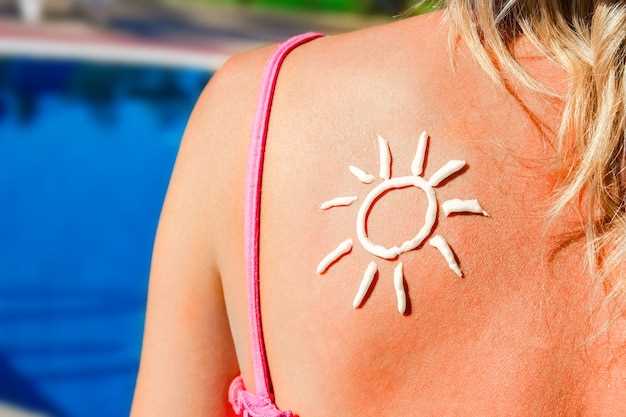
Are you concerned about sun sensitivity while taking seroquel?
Seroquel is a popular medication prescribed for the treatment of various mental health conditions, such as bipolar disorder and schizophrenia. While it can provide much-needed relief, it is important to be aware of potential side effects.
One potential side effect that you may have heard about is sun sensitivity. This means that your skin may become more sensitive to the sun’s rays, putting you at a higher risk of sunburn and other skin damage.
But does seroquel really cause sun sensitivity?
Experts suggest that the answer is yes. The active ingredient in seroquel, quetiapine, can make your skin more sensitive to the sun. This means that you may burn more easily and experience quicker skin damage from the sun’s UV rays.
It’s important to take precautions if you are taking seroquel and plan on spending time in the sun. Be sure to wear protective clothing, such as a hat and long-sleeved shirt, and use sunscreen with a high SPF. Avoid prolonged sun exposure, especially during peak hours when the sun is strongest.
If you have any concerns about sun sensitivity while taking seroquel, it’s always best to consult with your healthcare provider. They can provide personalized advice and help you navigate the potential risks and benefits of this medication.
Remember, taking care of your skin and protecting yourself from the sun’s harmful rays is always important, especially if you are taking medications that may increase your sun sensitivity.
Overview of Seroquel
Seroquel is an antipsychotic medication primarily used to treat certain mental/mood conditions such as schizophrenia and bipolar disorder. It works by helping to restore the balance of certain natural substances (neurotransmitters) in the brain. This helps to improve mood, thinking, and behavior.
Seroquel is available in tablet form and is usually taken once or twice a day as prescribed by a healthcare professional. The dosage may vary depending on the specific condition being treated and the individual’s response to the medication.
It is important to take Seroquel exactly as prescribed and not to abruptly stop taking the medication without consulting with a healthcare professional. Suddenly stopping Seroquel may lead to withdrawal symptoms or a reoccurrence of the condition being treated.
How Seroquel Works
Seroquel belongs to a class of medications known as atypical antipsychotics. It works by blocking the receptors of certain neurotransmitters in the brain, including dopamine and serotonin. This helps to regulate and stabilize the activity of these neurotransmitters, which can alleviate symptoms associated with mental/mood disorders.
Possible Side Effects
Like any medication, Seroquel may cause side effects. These can range from mild to severe and can vary from person to person. Common side effects include drowsiness, dizziness, dry mouth, constipation, and blurred vision. It is important to discuss any concerning or persistent side effects with a healthcare professional.
In rare cases, Seroquel may cause more serious side effects such as high blood sugar, high cholesterol, weight gain, and movement disorders. It is important to be aware of these potential risks and to discuss them with a healthcare professional before starting Seroquel.
Disclaimer: The content provided here is for informational purposes only and should not be used as a substitute for professional medical advice, diagnosis, or treatment. Always seek the advice of your physician or other qualified health provider with any questions you may have regarding a medical condition.
Sun Sensitivity Explained
When it comes to sun sensitivity, it refers to a condition where a person’s skin becomes more sensitive or reactive to sunlight. Sun sensitivity can manifest in various ways, including sunburns, rashes, and increased risk of developing skin cancer.
Causes of Sun Sensitivity
There can be several causes for sun sensitivity, including certain medications, medical conditions, and genetic factors. One medication that has been associated with sun sensitivity is Seroquel.
Seroquel and Sun Sensitivity
Seroquel is an atypical antipsychotic medication that is commonly used to treat psychiatric disorders such as schizophrenia and bipolar disorder. One of the potential side effects of taking Seroquel is increased sun sensitivity.
Studies have shown that Seroquel can make the skin more vulnerable to the harmful effects of ultraviolet (UV) radiation. This can lead to an increased risk of sunburns and other skin reactions when exposed to sunlight.
Why Does Seroquel Cause Sun Sensitivity?
The exact mechanism by which Seroquel causes sun sensitivity is not fully understood. However, it is believed that the medication may interfere with the body’s ability to repair DNA damage caused by UV radiation. This can result in an increased susceptibility to sunburns and other skin reactions.
Protecting Yourself from Sun Sensitivity
If you are taking Seroquel, it is important to take precautions to protect yourself from sun sensitivity. Here are some tips:
- Avoid prolonged sun exposure, especially during peak hours when the sun is strongest.
- Wear protective clothing, such as long sleeves, pants, and a wide-brimmed hat.
- Apply broad-spectrum sunscreen with a high SPF regularly and generously.
- Seek shade whenever possible, especially if you begin to feel any signs of sunburn or skin irritation.
- Stay hydrated and drink plenty of water to help keep your skin healthy.
By following these precautions, you can reduce your risk of sunburns and other skin reactions while taking Seroquel.
The Link Between Seroquel and Sun Sensitivity
When taking Seroquel, individuals may experience an increased sensitivity to sunlight. This means that exposure to the sun can lead to adverse reactions and potential side effects. It is important to understand the link between Seroquel and sun sensitivity in order to take necessary precautions and minimize risks.
How Does Seroquel Cause Sun Sensitivity?
Seroquel belongs to a class of medications known as atypical antipsychotics. While the exact mechanism of how Seroquel causes sun sensitivity is not fully understood, it is believed that the medication affects the body’s ability to regulate temperature and respond to ultraviolet (UV) radiation.
UV radiation from the sun can cause damage to the skin, leading to sunburn, skin rashes, and other adverse reactions. When taking Seroquel, the skin’s ability to protect itself from UV radiation may be compromised, increasing the risk of sun sensitivity.
Risks and Precautions
It is important for individuals taking Seroquel to be aware of the risks associated with sun sensitivity. Exposure to sunlight while on Seroquel can increase the likelihood of sunburn, skin rash, and other skin reactions. In severe cases, it can lead to photosensitivity reactions, which may require medical attention.
To minimize the risks of sun sensitivity while taking Seroquel, it is recommended to take the following precautions:
| 1. Use Sunscreen: | Apply a broad-spectrum sunscreen with a high sun protection factor (SPF) regularly, especially when spending time outdoors. |
| 2. Wear Protective Clothing: | Cover exposed skin with long-sleeved shirts, pants, wide-brimmed hats, and sunglasses to reduce direct sun exposure. |
| 3. Seek Shade: | Avoid direct sunlight during peak hours, typically between 10 am and 4 pm when the sun’s rays are the strongest. |
| 4. Stay Hydrated: | Drink plenty of water to stay hydrated, as Seroquel may affect the body’s ability to regulate temperature. |
| 5. Consult a Healthcare Professional: | If experiencing severe sunburn, skin rash, or other reactions, it is important to seek medical advice. |
By following these precautions, individuals can minimize the risks associated with Seroquel-induced sun sensitivity and enjoy outdoor activities with greater peace of mind.
Risks and Precautions
While Seroquel can be an effective treatment for various conditions, it is important to be aware of the potential risks and precautions associated with its use. Sun sensitivity is one of the side effects that some individuals may experience while taking Seroquel.
When exposed to sunlight, certain medications, including Seroquel, can make your skin more sensitive to the sun’s harmful rays. This can lead to a higher risk of sunburns, rashes, and other skin irritations. It is crucial to take precautions to protect your skin while taking Seroquel to minimize these risks.
Here are some tips to help manage sun sensitivity while taking Seroquel:
- Apply sunscreen: Before stepping outside, apply a broad-spectrum sunscreen with a high SPF to all exposed areas of your skin. Reapply every two hours, especially if you are sweating or swimming.
- Wear protective clothing: Cover up your skin with long sleeves, pants, a wide-brimmed hat, and sunglasses to shield yourself from the sun’s harmful UV rays.
- Avoid peak sun hours: Try to limit your time outdoors during the peak sun hours, typically between 10 am and 4 pm, when the sun’s rays are the strongest.
- Seek shade: If possible, stay in the shade or under an umbrella to reduce your direct exposure to the sun.
- Stay hydrated: Drink plenty of water throughout the day to help keep your skin hydrated and minimize the risk of dehydration when exposed to the sun.
It is essential to consult with your healthcare provider about any potential risks and precautions associated with taking Seroquel. They can provide personalized advice based on your individual medical history and help you manage your sun sensitivity effectively.
Managing Sun Sensitivity While Taking Seroquel

If you are taking Seroquel and experiencing sun sensitivity, there are several steps you can take to manage this side effect. Here are some tips:
1. Avoid direct sunlight
To minimize the risk of sunburn or sun-related skin damage, try to avoid direct sunlight, especially during peak hours between 10 am and 4 pm. If you need to be outside, seek shade or use an umbrella to protect yourself from the sun’s rays.
2. Wear protective clothing
When venturing outdoors, make sure to cover your skin as much as possible. Wear long sleeves, pants, and a wide-brimmed hat to provide additional protection from the sun. Choose clothing made from lightweight, breathable fabrics to stay cool.
3. Use sunscreen
Apply sunscreen with a high SPF (at least 30) generously and reapply every two hours, or more frequently if sweating or swimming. Look for a broad-spectrum sunscreen that protects against both UVA and UVB rays.
4. Seek shade
If you’re spending time outside, try to stay in shaded areas whenever possible. This can help reduce your exposure to direct sunlight and minimize the risk of sunburn.
5. Wear sunglasses

Protect your eyes from the sun by wearing sunglasses that block both UVA and UVB rays. Look for sunglasses with a UV protection rating of 100% to ensure maximum protection.
6. Stay hydrated
Drinking plenty of water can help keep your skin hydrated and reduce the risk of sunburn. Make sure to drink enough fluids, especially during hot weather or when engaging in physical activity outdoors.
By following these tips, you can help manage sun sensitivity while taking Seroquel and enjoy the outdoors more comfortably. Remember to always consult with your healthcare provider if you have any concerns or questions about managing this side effect.
